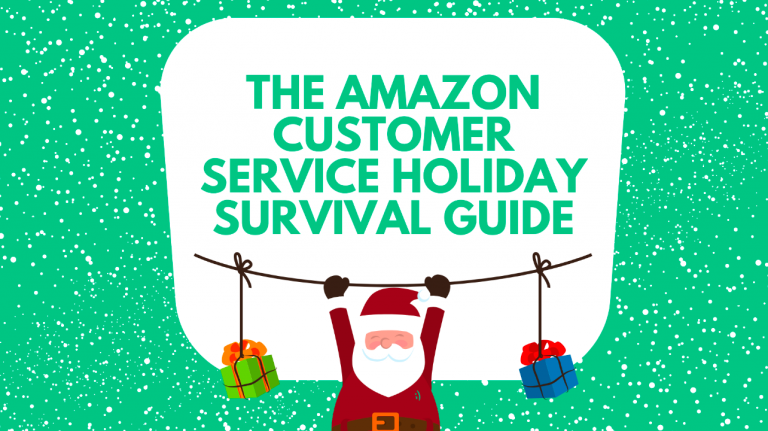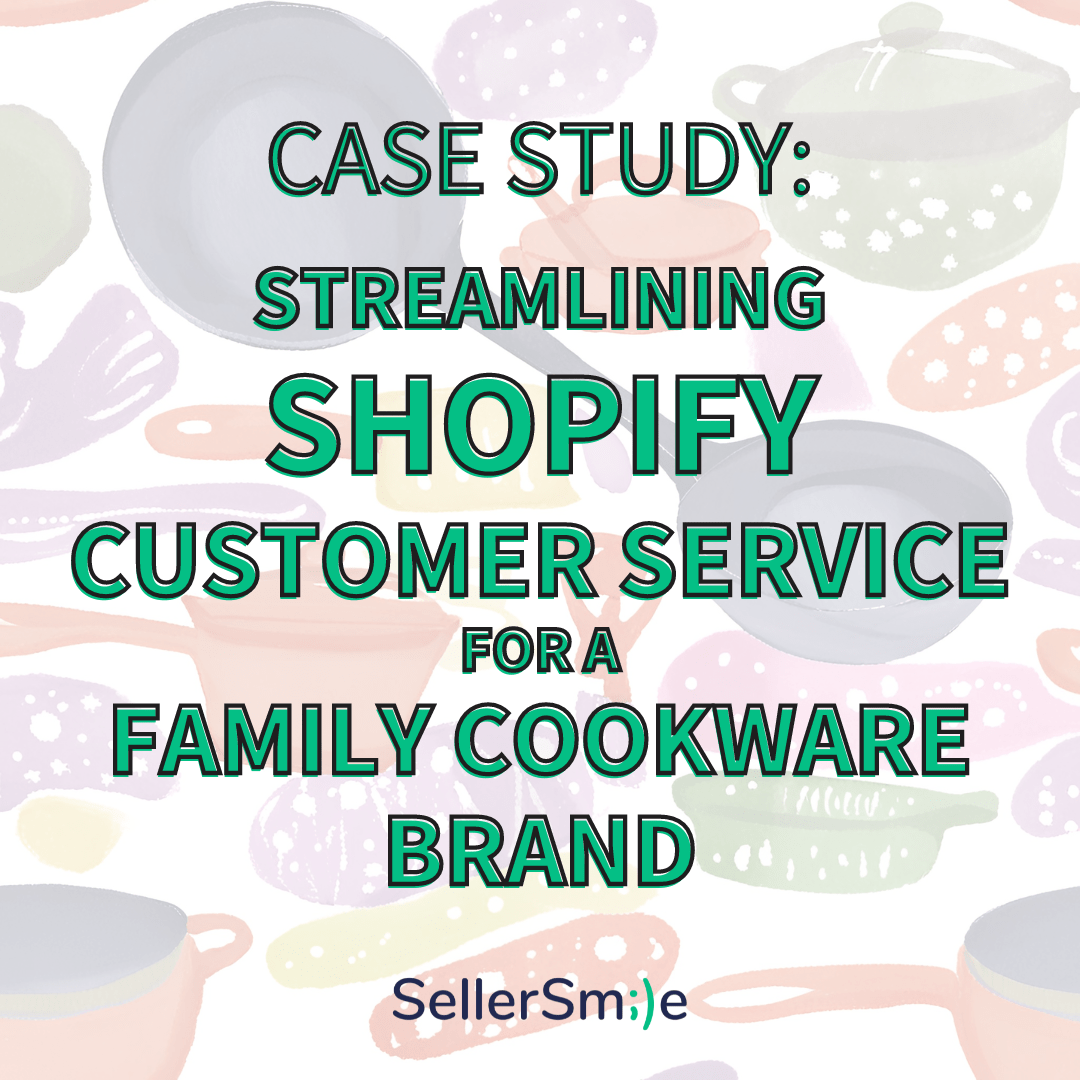Download the ebook version:
The Amazon Customer Service Holiday Survival Guide (.PDF 393 Kb).
Listen to the audio version:
Introduction
The holiday season in the US can feel like a whirlwind of craziness, similar to the movie Christmas with The Kranks. Perhaps even more so for Amazon sellers! This is why we’ve compiled a list of the seven most impactful holiday season changes regarding your Amazon customer service and our recommended strategies on how to survive to make this holiday season less stressful than ever before!
Holiday season change #1: Busy, busy, busy!
What happens
Even without the added pressures of being an Amazon seller, the holidays are a busy time from start to finish. Regardless of your race, religion, or country of origin, if you’re a seller, you’re aware that from November through January there is more to do and see! We’ve counted at least eight important dates or holidays that will impact your personal life and business:
- Black Friday (the Friday following Thanksgiving Day)
- Cyber Monday (the Monday following Thanksgiving Day)
- Thanksgiving (the fourth Thursday of November)
- Hanukkah (begins at the 25th day of Kislev and concludes on the 2nd or 3rd day of Tevet)
- Christmas Eve (December 24th)
- Christmas Day (December 25th)
- New Year’s Eve (December 31st)
- New Year’s Day (January 1st)
Besides these major dates, you’re also likely attending parties, holiday shopping, taking days off, planning for school breaks, travel, leisure, weather-related delays, and of course, family time! Not to mention, it’s also cold & flu season.
Many sellers see a dramatic increase in sales that is either a spike before/during certain holidays or is sustained throughout the months of November through December.
Why it’s stressful
Despite of all of this cheer, your Amazon customer service must continue seven days a week, 365 days a year! Amazon holds sellers to the 24 hour SLA (Service Level Agreement) even on holidays!
More sales means more customer interactions coming from multiple channels including Amazon Buyer-Seller messages, website emails, AMZ Customer Q&A, product reviews, seller feedback, phone calls, return request authorizations, etc.
Holiday shoppers will bring a greater amount of inquiries about shipping times, return policies, and gift receipts. A higher amount of customer contact means more time spent on customer service.
With this uptick in communications, a case backlog can occur, which may lead to more negative reviews, poor customer experiences, and even more emails! Buyers themselves tend to feel more stress and an increased urgency due to holiday shopping and the typical gift-buying procrastination. This is stressful for you and/or your customer service team, especially if they have to work longer hours to manage the caseload.
With more shoppers on all platforms, it’s common for sellers to see their advertising spend increase several times more than normal. If mismanaged, this rise in spend can kill your holiday season profit, which is why many experts recommend to place special attention on your advertising campaigns.
How to survive
Use email templates to keep your response times low.
Make sure that you have a reliable source of email templates readily available. If you handle your own customer service you may not have templates already saved as you’re likely the expert on your product line and know how to reply without referencing your FAQ every time. However, starting an email with the appropriate template or combination of templates is the best way to reply quickly, clearly, and with fewer errors. Well-organized templates also allow you to easily hand off this task to others.
Take some time to look through your most recent customer interactions and take special note of any recurring inquiries you receive. Craft the best possible templates for these scenarios and save them on a Word or Google Doc. Make them comprehensive and be sure to double check them for grammar too. Free tools such as Grammarly, Hemingway and QuillBot make this process easier.
As an extra bonus for the holiday season, we recommend you create a new section with holiday-specific blurbs and templates. Where appropriate, add cheerful messaging such as “Happy holidays!” along with your sign off.
Keep in mind that during the holidays, more buyers are purchasing gifts for others. This may warrant the use of even more straightforward and helpful messaging and it’s an opportunity to craft templates related to the changes in Amazon’s holiday return policy with helpful dates for your customer’s reference.
We have some starter templates you can use to start your library here. Please note: even though templates save time, we always encourage customizing messages to your company’s tone and the buyer’s unique reason for contact.
Route all of your buyer communication into one place.
One of the easiest ways to streamline responding to your buyers is to route all of your buyer interactions into one destination. This is especially helpful if you receive buyer inquiries through more than one source, like multiple Amazon marketplaces (Amazon.com, Amazon.ca, Amazon.co.uk, etc.), a website contact form, or additional e-commerce channels (eBay, Walmart, etc.).
We’ve previously provided steps and recommendations for how to forward all of your buyer messages to one inbox. You can read more about those recommendations here.
If you don’t funnel your messages to one application, you’ll have to manually go to each platform in order to reply to all of your messages. With this workflow, it is difficult to know which marketplace or source is closest to SLA and requires your earliest attention.
Outsource and delegate!
As a seller, time is your most valuable asset. Time can never be recovered and you must always be dedicating your time to high value and high urgency tasks over all others. Before things get too busy, consider your options for outsourcing less valuable/urgent tasks. Some questions to consider:
- Where are you currently a bottleneck in your business?
- Is there a single point of failure on your team? Will things keep running if you’re busy with holiday festivities or if you’re sick?
- Which repetitive tasks can be broken down into steps and outsourced to others?
- What is the true amount of time these tasks take you?
- What are you willing to pay for these tasks to be taken off of your plate?
- Which high value/ high urgency tasks demand even more of your focus?
Whether this means hiring an employee, a freelancer, a friend, a family member, or an agency like SellerSmile, considering these questions will help determine the best possible solution for your needs.
“The 4-Hour Work Week” by Tim Ferriss explains this concept using the D.E.A.L. acronym:
Define: Define your goal/lifestyle in a quantitative way.
Eliminate: Eliminate the things that are not required.
Automate: Automate repetitive tasks. Remove the trivial and leave the critical few.
Liberation: Be free.
Outsourcing is one of the fastest paths to liberation since it allows you to eliminate/automate through the help of others. Your next task should be to focus on high value/ high urgency tasks such as managing your advertising or inventory.
BONUS TIP: Listen to the Keyword Podcast episode on Sponsored Products Holiday Strategy.
Protect your time.
During the holiday season it’s more important to protect your time and avoid distractions. This means saying “No” more often. Saying “Yes” feels good but it can become a trap and you may find yourself suddenly overcommitted and drowning in unfinished work.
Derek Sivers, founder of CD Baby, uses the helpful rule of “Hell yeah” or “No”. If you’re not sure if you should do something, if it isn’t a “Hell yeah!”, then say “No!” instead.
Are the tasks you’re taking on delivering value to your business? To your life? If they aren’t, reconsider saying “yes” next time.
For other great reads about this idea, we recommend the article 7 No-Nonsense Pieces of Startup Advice I Wish I Got When I Started by Alex Turnbull of GrooveHQ and The Art Of Saying NO by Damon Zahariades.
Holiday season change #2: More traffic on your listings
What happens
An increase in traffic coming from holiday shoppers means more eyes on your listings and customer-facing copy.
Why it’s stressful
If your customer-facing copy (listings, automated emails, email templates etc.) isn’t dialed in, you’ll be spending a lot of extra time answering the same questions over and over again. Customer-facing copy that is confusing or outdated will produce questions and frustration. Customer-facing copy that is updated and optimized across all platforms will reduce confusion and unnecessary emails.
Improve the buying experience for holiday shoppers who may already be under pressure purchasing last minute gifts by making your messaging and text clear, accurate, and comprehensive.
How to survive
Review your listings.
In anticipation of having more traffic to your listings, consider revisiting them with fresh eyes. Some questions to ask yourself could include:
- Does your listing clearly state what is included? (Do your product images include other items that are sold separately?)
- Does your product packaging copy match what is on your listing? (E.g. Are there any discrepancies between them such as different stated features, dimensions, material, etc.?)
- Does your product listing clearly explain all available sizes? (Does your listing need a sizing chart that could be used as a product image?)
- Are there specific or new aspects of your product that buyers should know? (Does your item tend to run larger/smaller? Is there a difference in material in comparison to other products? Has it been updated recently?)
- Which common questions can be added to your product description or FAQ?
Ask yourself the same questions if you sell on your own website or other marketplaces. Ensuring these channels do not have different vital product information in comparison to your Amazon store will help avoid customer confusion and any impact on buyer trust.
Your product listings are usually the first point of contact. Consider common inquiries and pain points that you can help answer proactively. Including as much helpful information as possible will help your buyers make the right decision and reduce unnecessary cancellations, returns, and stress.
Review your outbound messaging.
If you use a follow-up email system, ask yourself:
- Do customers know how to contact me?
- Do I offer a warranty? If so, does my messaging include all necessary details about your warranty?
- Are there common product questions I receive that could be answered right away?
Are there setup instructions I can include? (This may be a good opportunity to send a PDF e-book). - Is my messaging compliant with Amazon’s TOS? (Here’s a great resource from the Seller Labs team about TOS compliant messaging).
Test your shopping experience.
If you created your own listings, you may have missed the opportunity to address common pitfalls buyers encounter when purchasing from you. It’s easy to gloss over since you’re used to looking at your listings and you already know everything important about them.
With that in mind, it’s helpful to get a friend or family member to buy something from you and interview them about their experience. Ask them to review similar competitor listings before purchasing. After their purchase, send them a follow-up survey. This can be done through free tools such as Google forms.
After their purchase, ask them to answer your questions without referring back to the listing. Your survey might include open ended questions such as:
- What stood out to you when completing your purchase?
- Was there anything that was confusing or you weren’t sure of?
- Did you have any concerns when considering your purchase?
- Was there anything that other listings explained better?
- Do you know everything that is included with your purchase?
With most transactions, buyers will quickly skim through price, product reviews and other information before making their purchase. The person you survey will most likely not remember everything about your product or the purchase itself. Take special note of key details they may have missed or things that really stood out to them. This will help you determine what buyers may encounter during the regular buying experience. Use this feedback to consider updates with your offering.
Holiday season change #3: Amazon’s extended holiday return policy
What happens
During the holidays, Amazon offers buyers an extended holiday return policy which requires orders that are shipped between November 1st and December 31st be returnable through January 31st of the following year. This policy includes orders that are shipped by you (seller-fulfilled) and orders that are shipped by Amazon (FBA).
Why it’s stressful
Many shoppers will be buying gifts and many gifts won’t quite hit the mark. This can create an influx of customer service messages pertaining to returns: “How do I return this?”, “Why do I have to pay for return shipping?”, or “Please arrange the courier to pickup my return.”
Even in the smoothest return process, your customers will experience some element of hassle with going through a return, especially if it is for an item they were excited about.
How to survive
Create holiday extended return policy templates.
One easy way to save time on returns is to create email templates to use for scenarios where buyers will need to make a return. For reference, you can view Amazon’s buyer return policies: https://www.amazon.com/gp/help/customer/display.html?nodeId=15015721.
Your return messaging should be comprised of at least two new templates:
Template #1 – Return approved template.
- Include instructions on how to complete a return. Make sure instructions are catered to the order’s fulfillment type. You will need different instructions for orders fulfilled by Amazon or seller-fulfilled orders. If you use both fulfillment types, this will require separate templates for each scenario.
- Keep in mind the marketplace the buyer purchased through and include the appropriate return links.
- Include relevant deadlines for when the buyer should make their return by (E.g. January 31st of the following year.)
- If the buyer’s order was a gift, you might include extra information pertaining to returning gifts. See Amazon’s instructions for returning gifts on Amazon.com here.
- Include helpful and apologetic language to show buyers you want to make it right.
Template #2 – Return denied template:
- To be used for buyers who contact you about a return outside of the return policy window. Include the reason why the order cannot be returned (e.g. the order is now past the return window).
- Make sure to reference specific return window dates.
- If there are any alternate solutions for the buyer, include them with your response. You may offer a partial refund, a replacement and/or a discount on a future purchase. If you’re considering a more generous policy allowing buyers to return past the holiday returns deadline, consider what those limitations are and explain that in your reply. (e.g. “We normally cannot accept returns after the return window has passed but we would be happy to offer you _______”).
- The exact messaging you’ll need will vary depending on your store’s policies and the potential options you can offer your buyers. More on that below.
Consider alternate solutions.
Not only can returns be a hassle for your buyers, they can also negatively impact your Amazon seller metrics. With this in mind, it’s important to consider alternate options to returns. Some questions to ask yourself are:
- Do your policies allow you to offer an alternative solution? Maybe even to prevent returns?
- Can you offer buyers returnless refunds? Perhaps a subset of your products (e.g. $25 and below) could qualify for returnless refunds? We just wrote a post about seller-fulfilled Amazon return settings which you can read more about here.
- Could this policy be applied to orders fulfilled by Amazon, seller-fulfilled orders, website orders, all?
Keep in mind, while buyers may want to return your product now, how you handle their issue could determine whether or not they consider coming back to shop from you again in the future.
If you decide to offer alternate solutions, make sure to update your return templates appropriately.
Consider a similar returns policy for website orders.
If you sell through your own website, consider matching Amazon’s holiday return policies for your website orders.
Oftentimes, buyers may already expect you to offer the same return policy. We regularly interact with buyers who use a website contact form to seek help on their Amazon order and vice-versa. The shopper perception may already be skewed and from their point of view, it may not make a difference for them that they purchased through Amazon or through your website.
While selling on your own website may have different costs and policies than your Amazon storefront, even a temporary update to your website order policies for the holidays can go a long way. In lieu of a temporary website update, consider honoring special discounts on the other shopping platforms for customers who reference those discounts.
Considering your various return policies together and ahead of time will allow you to arrange solutions that will help reduce customer effort, confusion and frustration.
Take special note of extended returns with account analysis.
If you run any type of periodic analysis for your account, make sure to adjust for the extended return window in your reporting. This will have an obvious impact on your return rates, as well as your profitability.
We suggest anticipating at least an additional month or two following the end of the extended return policy on January 31st. You’re likely to still receive buyer inquiries related to returns after the deadline, so the following months may appear abnormal unless you take them into consideration.
Holiday season change #4: Increased risk of going out of stock
What happens
A greater volume of sales, inventory mismanagement, or bad luck could mean increased risk of going out of stock.
Why it’s stressful
Going out of stock is possibly the worst thing that can happen to an Amazon seller! Out of stock SKUs cost money. Not only will you lose sales, but your BSR (Best Seller’s Rank) could be compromised.
You might receive customer inquiries about expected restock dates and even requests to place a backorder or to remind them once it’s back in stock. If a customer takes the time to reach out to you about items that are out of stock, it’s safe to assume it matters to them and they feel disappointed. Additionally, added inquires will only further bog down your customer service.
How to survive
… Order more yesterday!
This may sound obvious but above everything else, stay in stock. If we haven’t said it enough, staying in stock is absolutely crucial as your business runs on its inventory. If you have a previous holiday season under your belt, review trends from last year. Which items increased in popularity? Which items went out of stock or came close to it? Do you have new products that may encounter a similar trend? Do you need to contact your supplier now?
If it’s your first holiday season, take the time to learn more from other sellers in order to make an educated guess on the possible impacts to your inventory. Seller Central seller forums or sites like Reddit and Facebook with communities for Amazon sellers will be a good resource.
Note that there are holiday deadlines to get your stock into FBA. Read more on key dates here.
Have a backup plan
If there’s a chance of running out of stock, think about possible solutions now. Your backup strategy will depend on your unique setup.
If you have inventory at your disposal, put it in a position to be accessed quickly. Depending on your business operations, this may entail having a seller-fulfilled listing as a backup to your Fulfilled by Amazon listing. You’ll also want to consider training your team in how to fulfill these types of orders. This will help make sure you can act quickly should it be necessary.
You might have a contingency plan to access reserve/ extra inventory to send it to FBA if early holiday sales are greater than expected.
Be ready for out-of-stock inquiries
If you do run out of stock and customers begin to inquire about when an item will be available again, take time to have messaging and a workflow in place for responding.
Your reply should be apologetic and offer an expected restock date if one is available. Additionally, keep an ongoing list of customers who reach out to you. Tools like Google Sheets or Google Docs are perfect for this. Your list should include their Amazon email address and which SKU/ASIN they were requesting so you can easily follow up with them later.
Once your items are available again, use your list and follow up with shoppers. Even if they may have initially been disappointed or purchased an alternative already, they will appreciate that you went the extra mile in letting them know.
While your follow up should be prompt (as soon as the inventory is available), we’ve worked with sellers who follow a similar process even several months later!
Holiday season change #5: Gift wrapping & Messaging
What happens
Holiday shopping is synonymous with giving and receiving gifts. Not only will buyers be looking for items to purchase for others, sometimes they’ll want to send their gift purchases directly to the receiver! You may see inquiries about gift wrapping and/or how to purchase items as a gift. Some of these services include:
- Gift wrap, box or bag appropriate for the item.
- Decorative ribbon.
- Printed card with your gift message on the top of the package.
You can read more about Amazon’s gift wrapping services on their help article here.
Why it’s stressful
During the holidays, buyers will be looking for gift wrapping options and you may see more questions about how it works. If you don’t already know about these options, you won’t have a helpful response when customers ask about it and you could lose the sale! Amazon offers options for “gift wrapping” and “gift messaging” but these must first be enabled in Seller Central to offer buyers these services.
How to survive
Configure “Gift Options” in your Seller Central account.
Fulfillment by Amazon (FBA) offers gift-wrapping services for eligible items. The best part is that it’s offered at no extra cost to sellers. During checkout, when customers indicate that an order is a gift, the product prices will not appear on the packing slip. However, the customer can elect to include the prices should they wish. The buyer’s choices will show on the packing slip available on the “Manage Orders” page in Seller Central.
By default neither “gift messaging” nor “gift wrap” services are enabled for your listings. Below are the steps for enabling these settings within your Seller Central account.
Account-wide settings:
- Login to your Seller Central account.
- From the “Settings” drop-down menu, select “Gift options.”
- From there you can configure your“Gift Message” and “Gift Wrap” options.
- Click “Edit” next to Gift Messaging or Gift-Wrapping, then enable the service for individual order items.
- Click “Continue” to save the setting.
- From here, you will modify and upload your inventory files to enable “Gift Options.” If you upload your inventory using text files or XML, you can use the “is-gift-message-available” field, or the “is-gift-wrap-available” field, or both to control which products are eligible for these options.
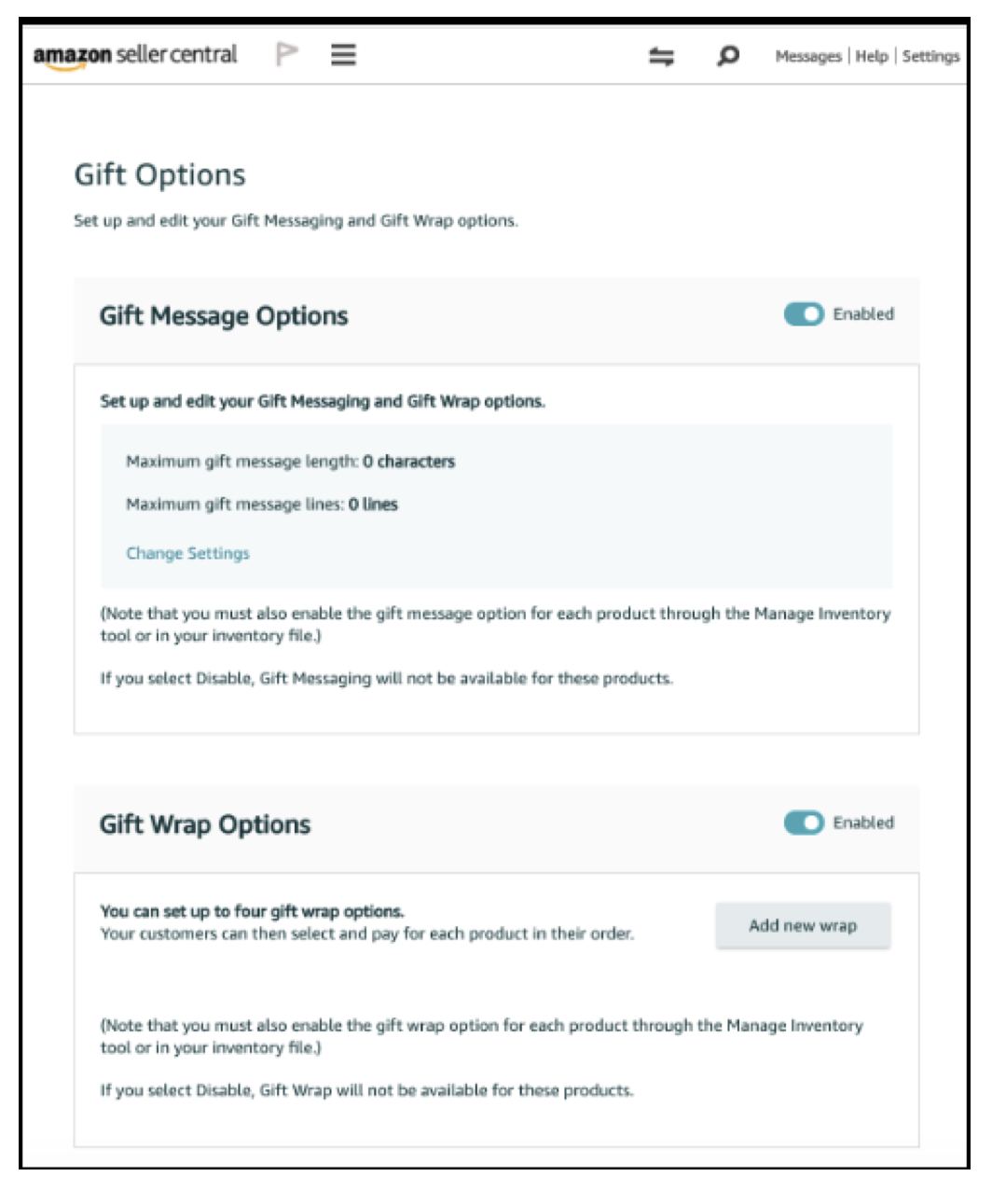
Note that if you select “Disable” for the settings directly from the account-wide settings, “Gift Wrap” will not be available for these products. Read more about these settings on Seller Central’s help article “Gift Options”.
These settings can also be enabled directly from your FBA listings:
- Login to your Seller Central account.
- Click on “Manage inventory.”
- Select “Edit” on the listing.
- Enable the “Advanced” view and click on the “Offer” tab.
- Modify the gift settings to your preference
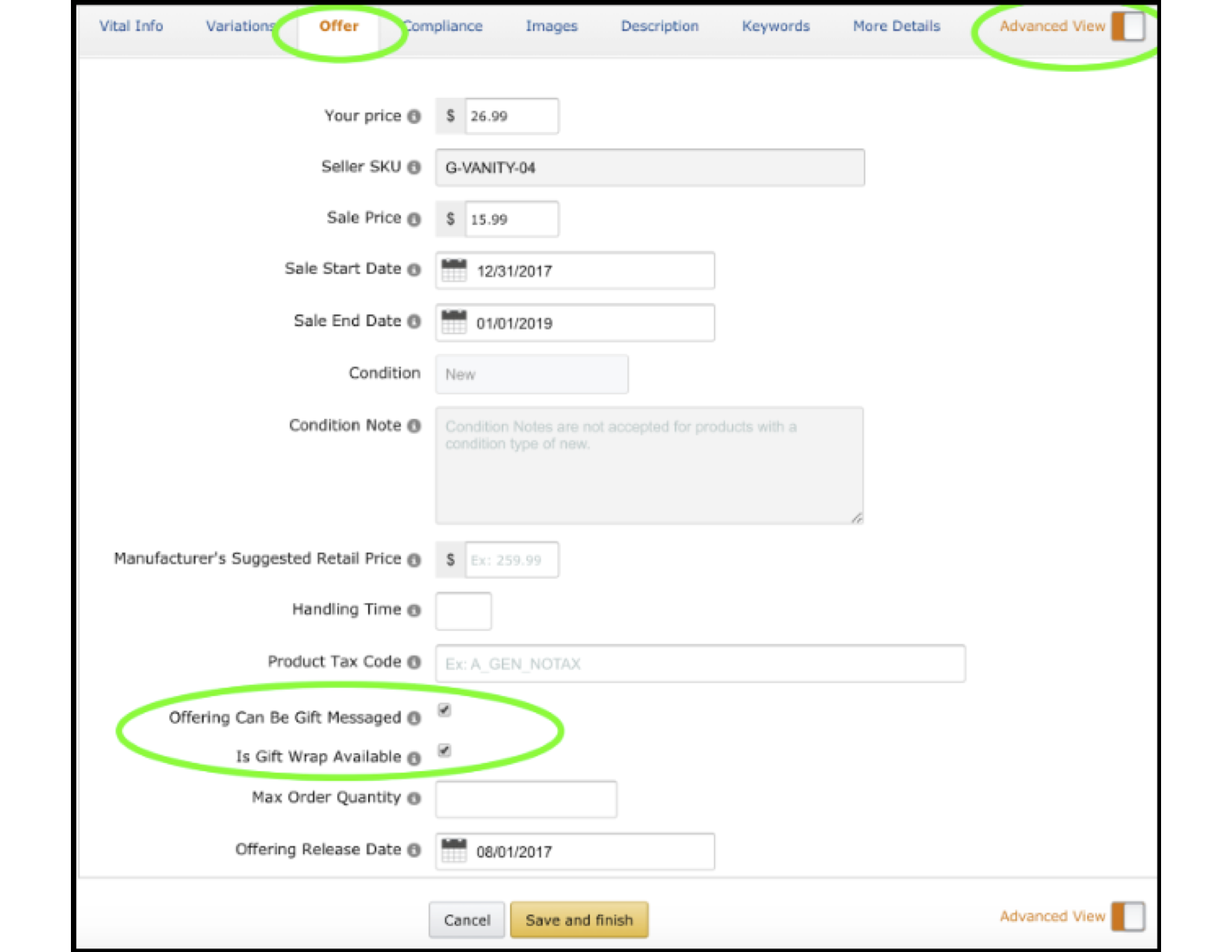
Lastly, you can also allow and enable gift wrapping and messaging services for your seller-fulfilled listings. Of course seller-fulfilled gift settings will require your team to handle the logistics and costs:
- Login to your Seller Central account.
- Click on “Manage inventory”
- Select “Edit” on the seller-fulfilled listing
- Modify the gift settings to your preference.
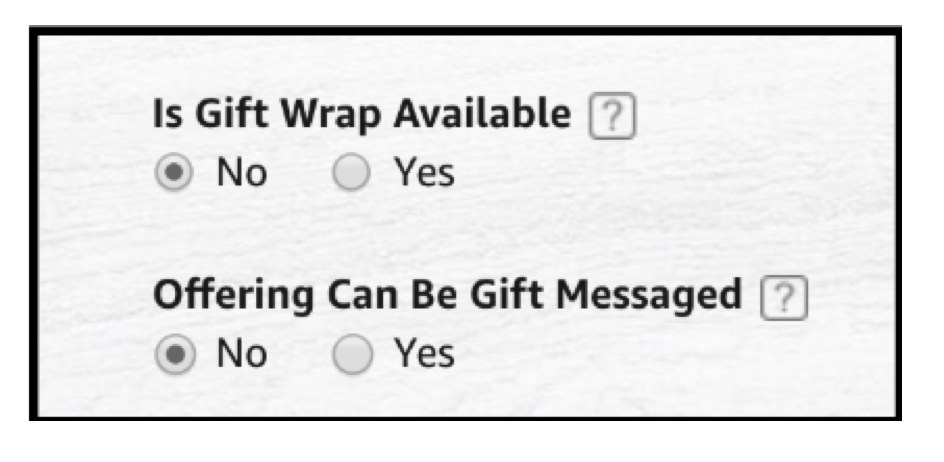
Know how buyers can return a gift.
If you do enable gift services you might receive inquiries on how to a return a gift. Amazon does accept these returns, but there are steps the buyer will need to take that you should be aware of as the seller.
To better understand these policies, and to compose instructions for your buyers, we recommend referencing Amazon’s help article on returning gifts.
It’s important to note that in the case where a gift is being returned, the resolution offered (refund or credit), will depend on how the gift was originally purchased and how it is returned. Additionally, gifts are not eligible for exchanges or instant refunds.
Holiday season change #6: More critical product reviews and seller feedback!
What happens
With an increase in sales comes an increase of product reviews and seller feedback. Unfortunately, this also includes an increase in negative reviews and feedback.
Why it’s stressful
As Amazon sellers know, negative product reviews and seller feedback can have a negative impact on your sales. In addition to decrementing your star ratings and lowering your BSR, this hurts your public reputation.
How to survive
Create or update your reputation management strategy.
In anticipation of an influx of product reviews and seller feedback, it’s important to have a reputation management strategy to make the best of these opportunities. Reputation management on Amazon is comprised of:
- Responding publicly to positive and negative product reviews.
- Responding publicly to positive and negative seller feedback.
- Following up with buyers to offer a resolution.
- Responding to customer questions in “Amazon Customer Questions & Answers.” We recently published, Amazon Seller’s Guide to Customer Questions & Answers, to help sellers with this customer service touchpoint.
Although Amazon’s TOS does not allow you to ask buyers to update their review, providing an excellent experience by doing your best to resolve issues fast can surprise buyers into a rating update and/or a repeat purchase.
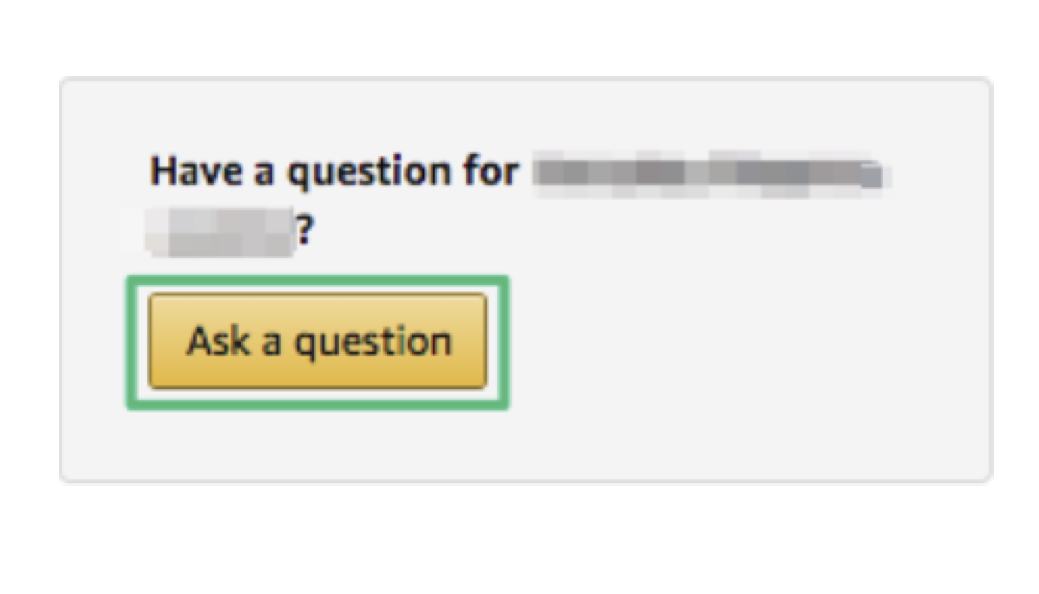
If you’re responding to a product review or seller feedback publicly, try to take the communication off the public forum to avoid future buyer confusion or other buyers taking advantage of a generous policy. Instead, point buyers to your Amazon “Contact” link, automatically routing to your Buyer-Seller messages. You can find your unique contact link by going to your public Amazon storefront and copying the link from the “Ask a question” button. You can also find this button from the “See how your feedback displays to buyers on Amazon” link on Feedback Manager.
When responding to buyers who left a negative review or feedback, be cautious of using language that could be misconstrued as combative, dismissive, or insensitive. It’s important to avoid sales-y/marketing language. Remember, your buyer will be more concerned with a resolution and not your brand’s reputation.
Our team’s reputation management strategy:
- Publicly responding to all product reviews and seller feedback with a unique strategy and goal for each star rating.
- For 1-3 star ratings:
- Offer a public apology for the specific issue they experienced. Include any insight you may have into what may have occurred. Encourage customers to contact you directly through your contact link to reach a satisfactory resolution.
- Compose resolutions for most common reasons buyers leave a negative rating. While we do not recommend offering a resolution publicly, you need to have a resolution ready for each scenario when buyers do reach out in a private message. Your resolution could include a free replacement, a refund, or a promo code for a future purchase.
- Remember, you’re hoping the resolution will encourage reviewers to update their rating. You need to “wow” these customers more so than usual.
- For 4-5 star ratings:
- Show buyers immense gratitude for taking the time to leave you a review!
- Make a specific mention of something positive they mention in their review. (E.g. if it was a positive review for a gift they purchased for someone, include the following: “we’re glad to hear your father enjoyed these!”).
We suggest composing various templates for each star rating and offering a resolution to buyers through a direct message. You can find general templates we’ve composed for these scenarios here. Remember: these templates are only meant as a starter and your replies should always be customized.
While you may see some reviewers convert their negative ratings, this approach is primarily intended for future buyers who will see your customer service as being consistently responsive when customers have trouble.
Holiday season change #7: More replacement orders
What happens
Depending on your customer service strategy, during the holidays you may find yourself creating more replacement orders for customers who encountered an issue.
Why it’s stressful
Whether you’re creating replacement orders due to defects or warranty claims, it’s easy to lose track of them. The holiday uptick will make it increasingly difficult to know how many replacements you’ve issued. Keeping track of replacement orders and why you’re issuing them can be especially important when negotiating with your supplier or for making improvements to future production runs.
How to survive
Track all replacement orders using a simple naming convention.
If you use Amazon’s multi-channel fulfillment (MCF) order process, you know that you have the ability to specify the order-ID for each replacement. The interface will create its own order-ID by default, but you can use this field to enter your own. For example, if you are creating an MCF order for order #112-1234567-6122345, your replacement order ID to enter in the order-ID field could be “R112-1234567-6122345” or “Replacement-112-1234567-6122345”.
You could also further segment these by creating a nomenclature based on the category of the issue, such as “Defect-112-1234567-6122345” or “Warranty-112-1234567-6122345”. You can pair either of these strategies with a Google sheet to store images of the customer issues along with the order ID and other relevant information.
Using a similar method for replacement orders will allow you to come back and run a report on your orders, easily distinguishing how many replacement orders you issued, which orders these were for, and why they were issued.
Conclusion
Being an Amazon seller can add extra challenges to the most stressful time of the year. If you’re going through holiday prep madness, remember, “this too shall pass!”
Spend time considering these holiday season changes now, discuss them with your team so you can plan accordingly and enjoy your holidays with friends with a bit more relaxation.
We hope this survival guide will lead to some quick improvements in your customer service for the holidays.
If you need any help, or would like to learn more about how SellerSmile can take on your customer service this holiday season, feel free to schedule a call with us. We’re always happy to chat.
Happy holidays to you and your loved ones from the SellerSmile team!

